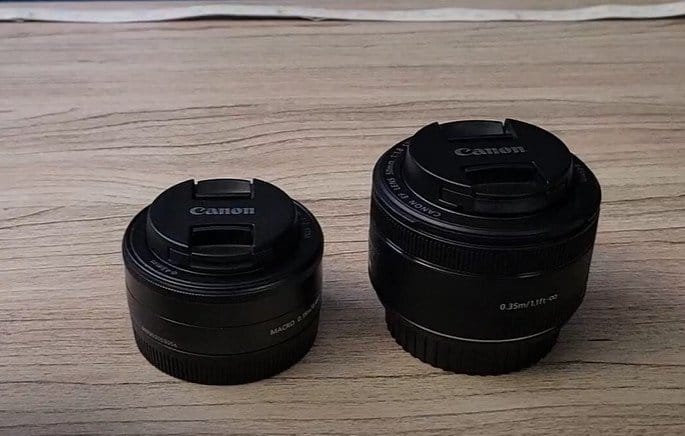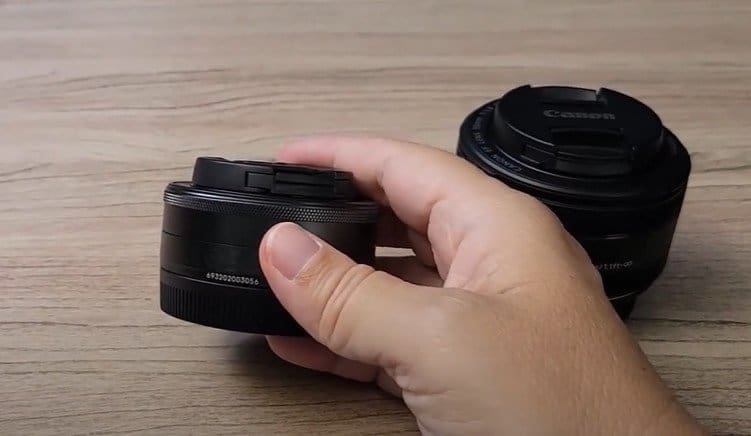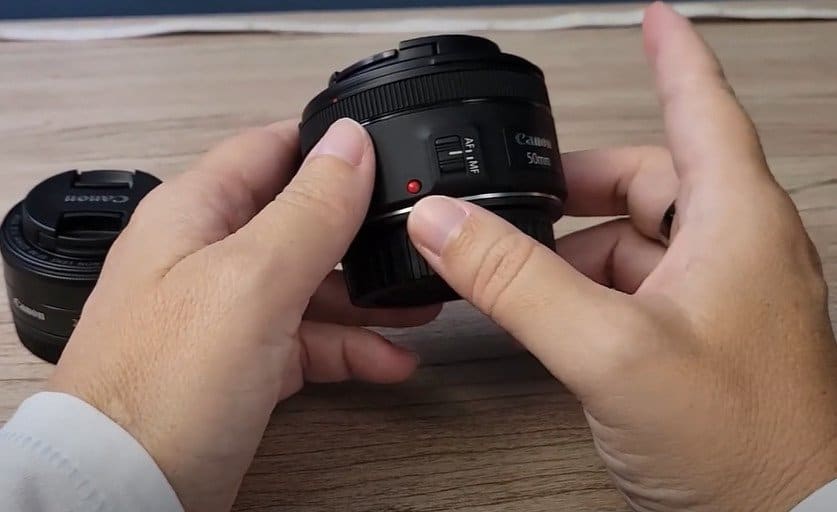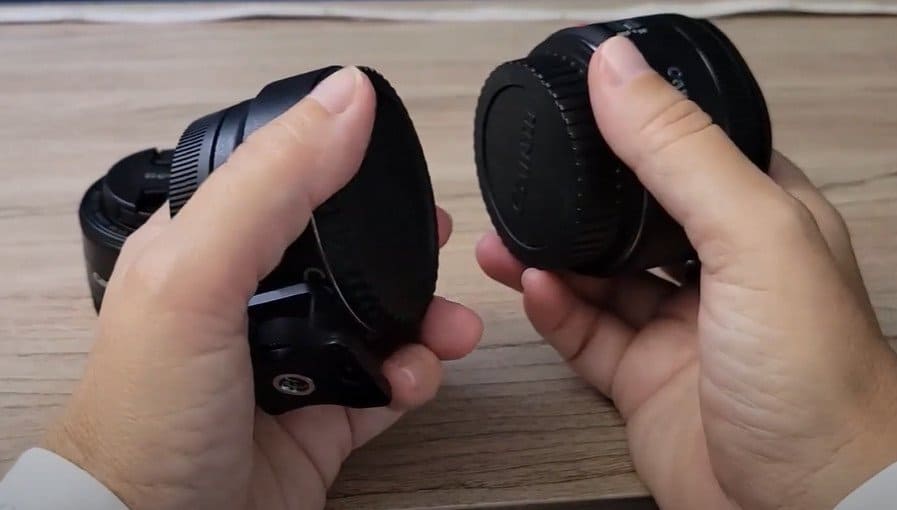I’ve been using both the Canon 22 and Canon 50mm lenses for years, and I want to share my experience. These lenses are great for getting that nice blurry background effect many people love. As an amateur photographer who mostly uses cameras for video, I’ve found each has its strengths.

The Canon 22 has become my go-to lens. It stays on my camera at my desk all the time. I rarely take it off because it does such a good job focusing on me and a bit of my surroundings. It’s perfect for my small office setup, hiding windows to my left and right while giving that professional blurry background look.
Key Takeaways
- The Canon 22 works well in small spaces, focusing on the subject while blurring the background
- The Canon 50mm is great for photography and achieving a bokeh effect in larger spaces
- Lens choice depends on your camera type and the size of your shooting area
Overview of Canon 22mm and Canon 50mm
I’ve been using both the Canon 22 and Canon 50mm lenses for years. They’re great for getting that nice blurry background effect people love. The Canon 22 is often called the “pancake” lens, while the 50mm is nicknamed the “nifty fifty.”
The Canon 22 is my go-to lens. It’s perfect for my small office setup, staying on my camera almost all the time. It keeps me in focus while blurring out just enough of the background. This helps hide distracting elements like windows on either side of me.
The 50mm is similar, but there are some key differences:
- It works best on DSLR cameras
- On my mirrorless camera, it zooms in too much (about 1.6x)
- I need an adapter to use it with my mirrorless cameras
For my desk setup, the 50mm gets too close to my face. But it’s great for photoshoots where you want that classic blurry background look.
Here’s a quick comparison:
| Feature | Canon 22mm | Canon 50mm |
|---|---|---|
| Nickname | Pancake | Nifty Fifty |
| Best for | Small spaces, video | Photoshoots, portraits |
| Adapter needed (mirrorless) | No | Yes |
| Zoom on mirrorless | Just right | Too close for desk setups |
In the end, I prefer the Canon 22 for my video work. It’s the perfect size for my face and doesn’t need any extra attachments on my mirrorless camera.
Advantages of the Canon 22 for Video
I’ve used both the Canon 22 and Canon 50mm lenses for years, and the Canon 22 has become my go-to for video work. It’s perfect for my small office setup. I keep it on my camera all the time because it does such a great job focusing on me and a bit of my surroundings.

The Canon 22 gives that nice blurry background effect many people want for their desk or office setups. It’s ideal for smaller spaces like mine. I don’t have to worry about showing too much of my office or the windows nearby.
Here are some key benefits of the Canon 22 for video:
- Fits perfectly on mirrorless cameras
- No need for an adapter
- Less bulky than the 50mm with an adapter
- Provides just the right framing for face-to-camera shots
- Creates a pleasing bokeh effect
For my mirrorless camera, the Canon 22 is simply easier to use. I don’t have to deal with adapters or extra weight. It’s a hassle-free option that delivers great results for my video needs.
Using the Canon 50mm in Smaller Spaces
I’ve been using both the Canon 22mm pancake lens and the Canon 50mm (also known as the nifty fifty) for years now. They’re great for getting that nice blurry background effect that many people love. But I’ve found the 22mm pancake lens works better in my small office setup.
The 22mm lens stays on my desk camera all the time. It’s perfect for focusing on just me and a bit of my surroundings. In my tiny office, I don’t want to show too much of the space around me. This lens hides the windows on either side and keeps the focus where I want it.

The 50mm, while similar, has some drawbacks for my setup:
- It’s too zoomed in on my face in my small space
- I need an adapter to use it with my mirrorless camera
- The adapter adds extra bulk
My mirrorless camera already has a 1.6x crop factor. When I put the 50mm lens on, it zooms in even more – it’s like using an 80mm lens! That’s way too close for my desk setup.

If you have more room or you’re doing photo shoots, the 50mm could be a great choice. It’s loved for portraits and that blurry background look. But for tight spaces like my office, the 22mm pancake lens is just right.
Lens Suitability for Office Setups
I’ve been using both the Canon 22mm “pancake” lens and the Canon 50mm “nifty fifty” for years now. For my office setup, the 22mm is my go-to choice. It stays on my desk camera all the time. Why? It’s perfect for focusing on just me and a bit of my surroundings in my small office.
The 22mm lens gives that nice blurry background effect many people want for their desk setups. It hides the windows on either side of me and keeps the focus where it should be – on me.
The 50mm lens can do similar things, but it has some drawbacks for my setup:
- It’s too zoomed in for my small office
- On my mirrorless camera, it’s even more zoomed due to the crop factor
- I need an adapter to use it with my mirrorless camera
For bigger spaces or photo shoots, the 50mm is great. It’s loved for its bokeh effect. But in my tight office, it’s just too close to my face.
The 22mm wins for me because:
- It fits my small space perfectly
- No adapter needed
- Gives a nice blurry background
- Keeps focus on me without being too tight
If you have a bigger office or don’t mind using an adapter, the 50mm might work for you. But for my compact setup, the 22mm pancake lens is the clear winner.
Impact of Crop Factor on Lens Choice
I’ve been using both the Canon 22mm “pancake” lens and the Canon 50mm “nifty fifty” for years now. They’re great for getting that blurry background effect many photographers love. But which one should you pick? It depends on your camera and setup.
If you’re using a mirrorless camera like I am, the crop factor plays a big role. My camera has a 1.6x crop factor, which means a 50mm lens actually gives me an 80mm equivalent view. That’s often too zoomed in for small spaces.
The 22mm pancake lens has become my go-to for video work at my desk. It’s perfect for framing just me and a bit of my background, hiding messy areas in my small office. Plus, it still gives that nice background blur.
Here’s a quick comparison:
| Lens | Pros | Cons |
|---|---|---|
| 22mm pancake | – Great for small spaces – No adapter needed on mirrorless | – Less background blur than 50mm |
| 50mm nifty fifty | – Amazing background blur – Standard for portraits | – Too zoomed on crop sensor cameras – Needs adapter for mirrorless |
For DSLR users, the 50mm is often ideal. But on my mirrorless setup, it’s just too close for comfort. I’d need to use an adapter too, adding bulk and hassle.
In the end, I keep the 22mm on my camera almost all the time. It’s just right for my needs – giving me a nice balance of framing and background blur without any fuss.
The Convenience of Lens Selection
I’ve been using two great Canon lenses for years now – the 22mm pancake and the 50mm nifty fifty. Both give that awesome blurry background effect people love. As an amateur photographer who mostly shoots video, I’ve found the 22mm pancake to be my go-to lens. It stays on my desk camera all the time!
The 22mm is perfect for my small office setup. It keeps me in focus while blurring out distracting background elements like windows. This lens gives me that professional look without showing too much of my space.
The 50mm is amazing too, but it has some drawbacks for my needs:
- It’s too zoomed in on my mirrorless camera due to the crop factor
- I need an adapter to use it, adding bulk
- It’s a bit too close for face shots in my small office
For photography or larger spaces, the 50mm is fantastic. It’s a classic choice for portraits and that beautiful bokeh effect. But for my video setup, the 22mm pancake lens is just right. It frames me perfectly without needing extra adapters or space.
In the end, both lenses have their strengths. I love how easy it is to swap between them based on what I’m shooting. The right lens makes a huge difference in getting the look you want!
Considerations for Mirrorless Camera Users
As a mirrorless camera user, I’ve found some key differences between the Canon 22mm pancake lens and the Canon 50mm “nifty fifty” lens. Both are great for creating that beautiful blurry background effect, but they have distinct advantages in different situations.
The 22mm pancake lens has become my go-to for desk setups and small office spaces. It stays on my camera almost all the time because:
- It focuses well on me and a bit beyond
- It hides distracting elements in tight spaces
- It gives a nice blurry background
The 50mm lens, while popular, has some drawbacks for mirrorless users:
- Crop factor issues
- Needs an adapter
- Can be too zoomed in for small spaces
On a mirrorless camera with a 1.6x crop factor, the 50mm acts more like an 80mm lens. This makes it too close for face shots in small rooms. The adapter adds bulk and is a bit of a hassle to deal with.
For photo shoots or larger spaces, the 50mm shines. It’s great for portraits and that classic bokeh look. But for my daily video needs in a compact office, the 22mm pancake lens is perfect.

Leave a Reply